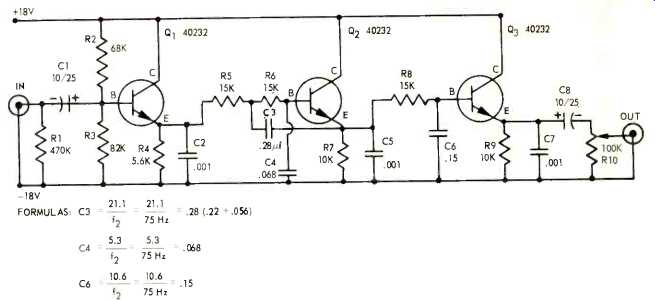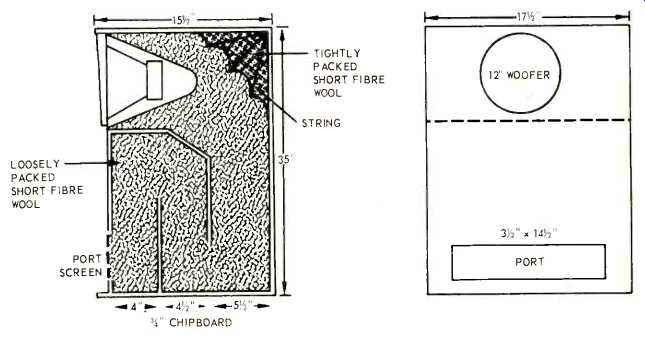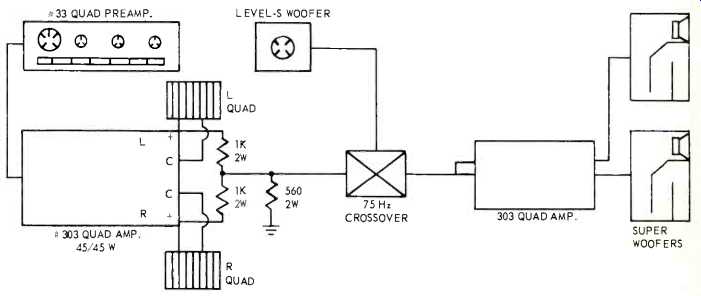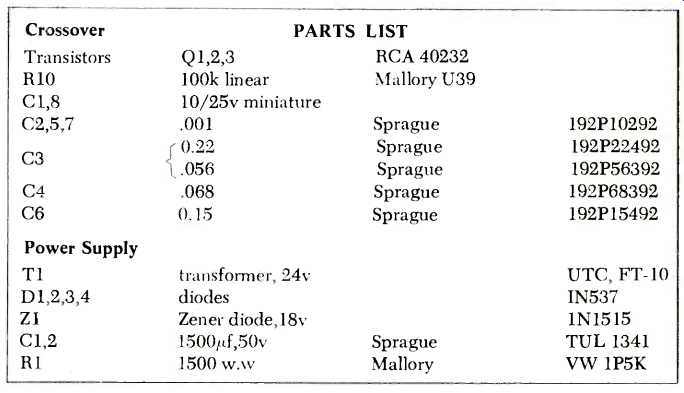By Nate Garfunkle
MANY ARTICLES DESCRIBING how to add an electrostatic tweeter to a woofer have appeared in the literature but I wanted to reverse the procedure and add a woofer to an electrostatic speaker. The reason is simple: I have a pair of Quad full-range electrostatic units which have superb transient response and clarity but I wanted to extend the low end to get those elusive lower-register notes of the Organ, Cello, Double Bass and Drums. I have heard the KLH-9's and Acoustechs but still did not feel those very low notes as experienced at live organ recitals and concerts, especially in such items as Verdi's "Requiem," Messiaen's "Nativite du Seigneur" (where the 27.5-Hz pedal tone is sustained for twenty-five seconds), and the opening of "Also Sprach Zarathustra" with its sustained 32-Hz pedal.
In the early days of Hi-Fi (?), a Bass Coupler was developed and tried: it produced a great amplitude of bass but was resonant, boomy, and colored in sound. Another type of enclosure investigated was the Paraline which is a type of labyrinth or pipe system popular in England. It requires very careful design and internal damping but does not go low enough in frequency for my test. Joseph Marshall wrote about "Super Woofers" in the May 1963 issue of Popular Electronics, and offered some fine suggestions. He stated that speaker manufacturers have done a remarkable job in designing compact stereo speaker systems which stand up well to the larger bass-reflex, infinite-baffle, and even horn-loaded systems, but all too often fall short at the low end.

Fig. 1--Schematic of crossover and formulas used to determine values.

Fig. 2--Details of woofer enclosure.
They cannot compare with the big speakers when it comes to reproducing the bass from real "live" drums, double basses and organ pedals. The drums do not sound as big or as "low down," the double basses do not roar, and the organ pedal tones rattle rather than rumble-the awesomeness is just not there! (This is a 1963 judgment and compact systems have improved since then: however, big speakers are still better than small ones-certainly as far as that bottom end is concerned. As a matter of interest, the Quad units fall off below about 70Hz and in any case are not recommended for extremely high power levels or in very large rooms. -Ed.) If all a system lacks is a good solid bass response, it can be improved by adding a bass speaker to cover the bottom two octaves. Sounds easy, but I have never heard it done without some resonances, doubling or coloration of one sort or another. Moreover, conventional crossover networks add resistance to the amplifier degrading the damping factor or "brakes" on the speaker cone. Some time ago Paul Weathers came up with an idea which promised to overcome these defects.
He mounted a 12-in. speaker in a small, folded coupler box and loaded the cone with fibrous material which added mass and reduced the resonant frequency. He used an electronic crossover ahead of the main amplifier to combine the low frequencies of both channels and feed them through the amplifier to the woofer. The crossover frequency was about 75 Hz and the system worked quite well but is not marketed any more. However, using some of Paul's ideas led us to look for a bass enclosure small enough to use in an average room in addition to the normal stereo speakers (Quads in my case). The electronic crossover should be designed to roll off at 18 dB per octave and here AUDIO magazine solved the problem with the solid-state circuit published in the July 1968 issue. All formulas were given and I used a cut-off of 75 Hz, like the Weathers system. Figure 1 shows the circuit and formulas.
Next, I looked back at a "Non Resonant" enclosure described in the October 1965 issue of the British Wireless World. This was developed, after much research, by Dr. Arthur Bailey for Radford, who hold the patents. A similar enclosure with a tapered line has been developed by IMF here and is being made in England. This was demonstrated at the recent Audio Fair in London and was apparently very impressive. Dr. Bailey's experiments showed that an acoustic line filled loosely with pure long-fibered wool to be practically non-resonant and could produce 84 dB at 22 Hz in a 20-by-40-foot room.
Cone movement is restricted thus minimizing intermodulation and Doppler effects. Here, I thought, is something that should meet my requirements and so I got to work.
Figure 2 shows the suggested dimensions. A low-resonant woofer works best here. Dr. Bailey used a KEF rectangular woofer, model B139.
As this was not readily available here, I used a Jensen W12 LF, a 12-in. unit with a free-air resonance of 20 Hz.
This was tried with a derived signal from two amplifiers and it worked very well. Next, in a burst of enthusiasm, I bought another speaker and built a second enclosure so I now had two Super Woofers in full Super Stereo, flanking the two Quad speakers (I also added another 303 Quad amplifier). This produced bass closer to "live" than I have heard from any system. On a recent 4-channel demonstration here put on by two local FM stations, I added two ADC 404 speakers for the rear channels. This brought us right into the Symphony Hall: the bass from Berlioz "Requiem" and some of the electronic music was so real and felt-it was startling! The system was set up using a Vega condenser microphone and a test record with the results shown in Fig. 3.
The room is 15 by 24 feet with a cement floor, rugs, and normal furnishings. Level control for the woofers is mounted next to the preamps so adjustments can be made to suit special music or compensate for program deficiencies and so on. As for power--there is plenty to spare--even for the young crowd! The power supply circuit is shown in Fig. 4.
All parts are readily available: wool can be obtained from Wool Grower's Associations at approximately $3.50 per lb. It takes one pound to fill 2.3 cubic feet and you will need 3 lbs. for the enclosures described.
Incidentally, this article was published in a much less detailed version in the British Hi-Fi News but so many letters were received from American readers asking for further information that I prevailed on AUDIO to publish this piece.

Fig. 3--Frequency-response curves from warble-tone source measured at 12
feet from the woofer enclosure.

Fig. 4--Schematic of power supply.

Fig. 5--Finalized system. Note that common-bass arrangement is used.
PARTS LIST

(adapted from Audio magazine, Mar. 1970)
Also see:
Koss electrostatic speaker system (May 1977)
= = = =